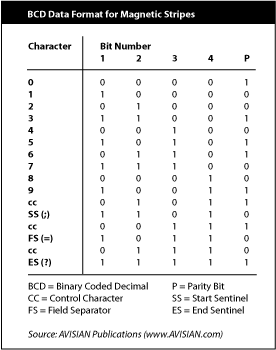
There are two distinct states for the magnetic particles: positive and negative polarity. A situation in which two and only two states are possible is referred to as a binary situation and forms the basis for all digital communications. All digital information is represented as a series of ones and zeros that, in a specific pattern, signify meaningful data such as alphanumeric characters, audio, or video.
In magnetic encoding the zeros and ones are actually positive and negatively charged areas of the magnetic stripe. Much like Morse Code represented letters and numbers via a series of dots and dashes, the positive and negative polarities do the same.
For the data encoded on a magnetic stripe to be meaningful to a reader that will ultimately access the data, the two must speak a common language. Thus, encoding schemes have been created to serve as these common languages. The two schemes commonly used in standard magnetic stripe encoding are the Binary Coded Decimal (BCD) Data Format and the Alpha Data Format, both standardized by the American National Standards Institute (ANSI) and the International Organization for Standards (ISO).
The BCD format uses a series of five individual zeros and ones (or bits) to signify each character. Four of these bits actually specify the character while the fifth serves as means for the reader to verify the accuracy of its read. This fifth bit is called the parity bit and it always ensures that there is an odd number of ones in the five-bit character. If the reader ever determines that a single character had an even number of ones, it would recognize that something was wrong and reject the reading, prompting the user to re-swipe the card.
In the BCD scheme, four bits make up each character and thus there is a maximum of 16 unique characters that can be represented (2 to the power of 4 or 2 x 2 x 2 x 2 = 16). Obviously, alphabetic characters cannot be used as there are 26 letters and only 16 available characters. The BCD provides the numeric character set (zero through nine) with six left to spare. These six characters are called framing and control characters and are used to signify functional descriptions to a reader. The Start Sentinel (SS) signifies the beginning of the string of meaningful data on the magnetic stripe. Prior to the SS, a series of zeros (referred to as syncing characters) gives the reader a chance to sync up with the bit string. The End Sentinel (ES) tells the reader that the string of meaningful data is complete. The Field Separator (FS) informs the reader that one block of data is complete and another is about to begin, for example the ID number is complete and the expiration data is beginning.

In the Alpha Data Format, seven bits or zeros and ones are used to represent each character. Similar to the BCD Format, the seventh bit is a parity bit so each character is actually signified using six bits. This enables the Alpha Format to represent 64 unique characters (2 to the power of 6 or 2 x 2 x 2 x 2 x 2 x 2 = 64). This is sufficient to enable a full alphanumeric character set to be presented including 26 letters, 10 numbers, and 28 remaining characters.




